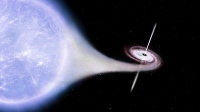INTEGRAL discovers gamma rays originating from black hole jets
24 March 2011
Can the powerful jets originating from the vicinity of black holes emit gamma rays? ESA's INTEGRAL observatory has shown that they can. An extensive study of Cygnus X-1, a binary system that hosts a black hole, has revealed polarized gamma-ray emission from this source, and shown that this high-energy emission originates from the jets that were originally detected in the radio band. This first discovery of polarized gamma rays from the vicinity of a black hole opens a new observational window on these enigmatic objects. The results of this study are published online today in Science Express.
 |
|
Artist's impression of Cygnus X-1. |
In a binary system, a black hole and a normal star are gravitationally bound and orbit each other around their common centre of mass. With its intense gravitational field, the black hole draws matter from its companion, and the stripped material spirals around the black hole, forming an accretion disc. As friction in the disc heats the material up to millions of degrees, making it shine in X-rays, these objects are known as X-Ray Binaries (XRB). First observed in the 1960s, soon after observations at these wavelengths became possible, these objects raised immediate interest as black hole candidates; furthermore, in the following decades, data gathered in the radio band revealed jets of relativistic particles emanating from several XRBs, suggesting that a link exists between accretion and ejection of matter in the proximity of such stellar black holes.
Astronomers call these objects 'microquasars' because they appear as miniature versions of quasars — the nuclei of active galaxies that harbour, in their cores, supermassive black holes that are millions of times more massive than their stellar counterparts. In spite of their very different sizes, black holes in both types of systems exhibit very similar dynamics, vigorously accreting matter from their surroundings via a disc and funnelling part of it, by means of the disc rotation, into highly collimated, bipolar jets of particles that are released at relativistic speeds.
"The connection between accretion and ejection of material in microquasars is well established by now, but many questions about the connection between the accretion disc and jets remain open," explains Philippe Laurent from CEA, France, who led the team that discovered highly polarized gamma-ray emission coming from Cygnus X-1, one of the best studied microquasars in the Milky Way. "Our study finally starts to answer some of these questions," he adds.
 |
|
Highly polarized gamma-ray emission from Cygnus X-1. |
This is the first time that polarized gamma-ray emission has been observed in a black hole binary system, and only the second time ever: in 2008, INTEGRAL detected polarized emission from the Crab Nebula. "INTEGRAL is the only instrument currently capable of performing polarimetry measurements in the gamma-ray band on astronomical sources other than the Sun," comments Chris Winkler, INTEGRAL project scientist at ESA. This is due to its particular configuration based on two separated detector planes, where incoming photons are initially scattered, in the first plane, and then absorbed in the second one. "By analysing the pattern described by the photons detected in the second plane, it is possible to infer whether the radiation is polarized or not," explains Winkler.
Since the polarized component is only a fraction, albeit large, of the total radiation, the signal is rather weak and it is thus necessary to stack a substantial number of observations of the same source in order to reveal polarization at a reasonable significance — even in this case, the detection is only possible for the brightest sources in the high energy sky. For the current study, the team has used all archival data for Cygnus X-1 collected by INTEGRAL over a period of almost 8 years.
"The discovery of polarized gamma-ray emission offers a brand new perspective to look at microquasars, since it also carries important information on the configuration of the source's magnetic field," continues Laurent. Together with further observations of the jets at radio wavelengths, this will allow a better characterisation of the mechanism producing gamma rays in these objects. "Future studies might reveal polarization also in other, less bright black hole binaries, thus shedding light on the overall accretion and ejection scenario in microquasars," he concludes.
Notes for editors
Cygnus X-1 is an X-ray binary system composed of a ~10 Msun black hole accreting matter from the companion, a 35 Msun blue O9 supergiant star, via an accretion disc. It is one of the brightest galactic sources in the high-energy sky and one of the first X-ray binaries to be discovered (soon after the advent of X-ray astronomy in the 1960s) in the Milky Way. Cygnus X-1 is also the first galactic source for which optical measurements, in the early 1970s, suggested the presence of a black hole, as both the optical and X-ray emission exhibit variability on very short time scales.
The study of Laurent and colleagues relies on observations performed with the IBIS telescope, onboard the INTEGRAL satellite, which can be used as a Compton polarimeter. In the energy range between 250 and 400 keV no polarization signal was detected, whereas in the energy range between 400 and 2000 keV the signal exhibits a clear signature of a high degree of polarization.
The team made use of the entire archive of INTEGRAL/IBIS data available on Cygnus X-1 as of June 2010.
Related publication
Laurent, P., et al., "Polarized Gamma-ray Emission from the Galactic Black Hole Cygnus X-1", published online in Science Express, 24 March 2011. DOI: 10.1126/science.1200848
Contacts
Philippe Laurent
Astroparticules et Cosmologie (APC)
CEA/IRFU
Paris, France
Email: plaurent cea.fr
cea.fr
Phone: +33-1-69088066
Jérôme Rodriguez
Laboratoire AIM
CEA/IRFU
Paris, France
Email: jrodriguez cea.fr
cea.fr
Phone: +33-1-69089808
Chris Winkler
INTEGRAL Project Scientist
Research and Scientific Support Department
Directorate of Science and Robotic Exploration
ESA, The Netherlands
Email: cwinkler rssd.esa.int
rssd.esa.int
Phone: +31-71-5653591

